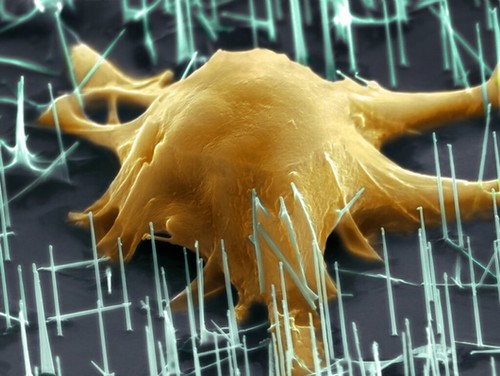
It was in Toronto, in the summer of 2006, that stem-cell research was turned upside down. I remember it clearly, but I didn't feel the earthquake at the time: a youngish, earnest Japanese researcher named Shinya Yamanaka gave a talk at the annual meeting of the International Society for Stem Cell Research, reporting that he could make mouse skin cells look and act like embryonic stem cells just by adding a few genes. The following year, both Yamanaka and Rudolf Jaenisch, a well-respected stem-cell researcher from MIT, reported that these induced pluripotent stem cells (known as iPS cells) passed the litmus test for pluripotency, or the ability to differentiate into all types of cells: when mouse iPS cells were injected into mouse embryos, the cells were incorporated into the developing mice.
Since then, research based on iPS cells has exploded (see "Medicine's New Toolbox," p. 40). Like embryonic stem cells, iPS cells can give rise to different types of tissue, but they offer a way to avoid both the ethical and practical hurdles of dealing with human embryos. Scientists have made human iPS cells from skin and hair follicles, as well as from tissue harvested from people with various ailments. Methods for making these cells are evolving at breakneck speed; the most recent development, as of this writing, is the transformation of human skin cells into iPS cells using proteins rather than the currently most common approach of genetic engineering.
Given the rapid successes of iPS-cell research, some have argued that we should abandon human embryonic stem cells. This is a very bad idea. We should continue, and even intensify, the study of these stem-cell lines.
We know much more about embryonic stem cells than we do about iPS cells. The relatively few embryonic-stem-cell lines in existence have been well characterized by many scientists. However, the rapidly growing number of iPS-cell lines, and the new methods of deriving them, have overtaken our capacity for characterizing them. There are too many iPS-cell lines to count, much less analyze.
Some iPS-cell lines are likely to bear close resemblance to embryonic stem cells. But others will be dearly different--perhaps more or less prone to develop into tumors, or with different degrees of potential for differentiation. IPS cells may be better than embryonic stem cells for some uses, but worse for others. We have to find out, not just guess, because people's health is at stake.
I embrace the new technologies, and I want to use them all, but we still need to pick the right cells for the right jobs. IPS cells and embryonic stem cells must be compared, directly, by a lot of scientists in a lot of ways before we can think seriously about what cells to use for medical applications.
JEANNE LORING IS FOUNDING DIRECTOR OF THE CENTER FOR REGENERATIVE MEDICINE AT THE SCRIPPS RESEARCH INSTITUTE IN LA JOLLA, CA.
Source Citation
Loring, Jeanne. "Cell fate: Jeanne Loring explains why we can't abandon embryonic stem cells." Technology Review [Cambridge, Mass.] 112.4 (2009): 12+. InfoTrac Environmental Issues and Policy eCollection. Web. 25 Mar. 2010.
Document URL
http://find.galegroup.com/gtx/infomark.do?&contentSet=IAC-Documents&type=retrieve&tabID=T003&prodId=SPJ.SP04&docId=A204034399&source=gale&srcprod=SP04&userGroupName=broward29&version=1.0
Gale Document Number:A204034399
Disclaimer:This information is not a tool for self-diagnosis or a substitute for professional care.



No comments:
Post a Comment